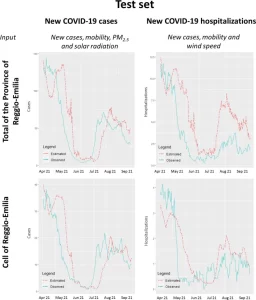AI applied to predicting the spread of the epidemic
A deep learning approach for Spatio-Temporal forecasting of new cases and new hospital admissions of COVID-19 spread in Reggio Emilia, Northern Italy. Journal of Biomedical Informatics (2022). Autori: V. Sciannameo, A. Goffi, G. Maffeis, R. Gianfreda, D.J. Pagliari, T. Filippini, P. Mancuso, P. Giorgi-Rossi, L.A. Dal Zovo, A. Corbari, M. Vinceti, P. Berchialla. DOI:10.1016/j.jbi.2022.104132.
ABSTRACT
Background: Since February 2020, the COVID-19 epidemic has rapidly spread throughout Italy. Some studies showed an association of environmental factors, such as PM10, PM2.5, NO2, temperature, relative humidity, wind speed, solar radiation and mobility with the spread of the epidemic. In this work, we aimed to predict via Deep Learning the real-time transmission of SARS-CoV-2 in the province of Reggio Emilia, Northern Italy, in a grid with a small resolution (12 km × 12 km), including satellite information.
Methods: We focused on the Province of Reggio Emilia, which was severely hit by the first wave of the epidemic. The outcomes included new SARS-CoV-2 infections and COVID-19 hospital admissions. Pollution, meteorological and mobility data were analyzed. The spatial simulation domain included the Province of Reggio Emilia in a grid of 40 cells of (12 km)2. We implemented a ConvLSTM, which is a spatio-temporal deep learning approach, to perform a 7-day moving average to forecast the 7th day after. We used as training and validation set the new daily infections and hospital admissions from August 2020 to March 2021. Finally, we assessed the models in terms of Mean Absolute Error (MAE) compared with Mean Observed Value (MOV) and Root Mean Squared Error (RMSE) on data from April to September 2021. We tested the performance of different combinations of input variables to find the best forecast model.
Findings: Daily new cases of infection, mobility and wind speed resulted in being strongly predictive of new COVID-19 hospital admissions (MAE = 2.72 in the Province of Reggio Emilia; MAE = 0.62 in Reggio Emilia city), whereas daily new cases, mobility, solar radiation and PM2.5 turned out to be the best predictors to forecast new infections, with appropriate time lags.
Interpretation: ConvLSTM (Convolutional Long Short Term Memory) achieved good performances in forecasting new SARS-CoV-2 infections and new COVID-19 hospital admissions. The spatio-temporal representation allows borrowing strength from data neighboring to forecast at the level of the square cell (12 km)2, getting accurate predictions also at the county level, which is paramount to help optimise the real-time allocation of health care resources during an epidemic emergency.

